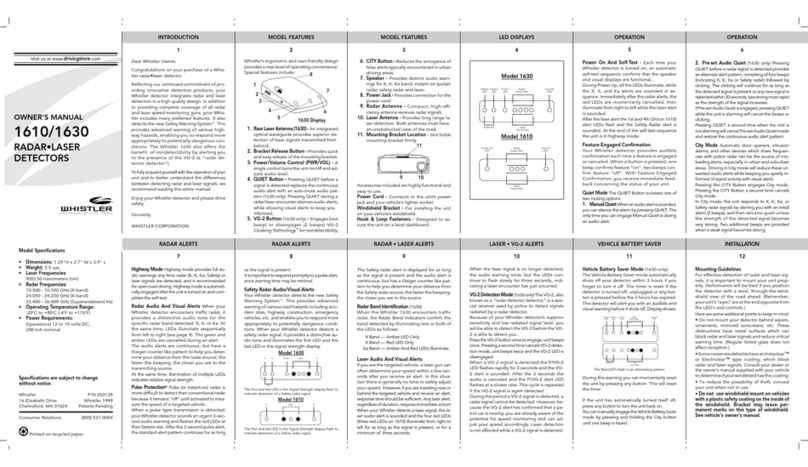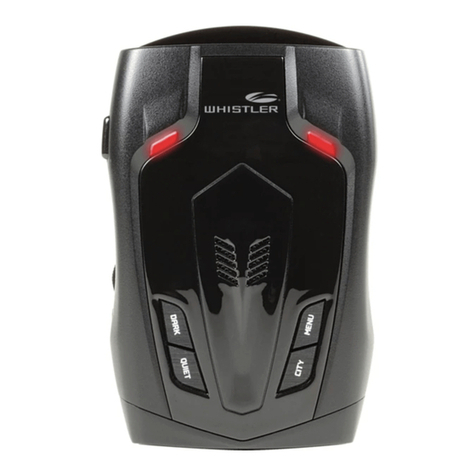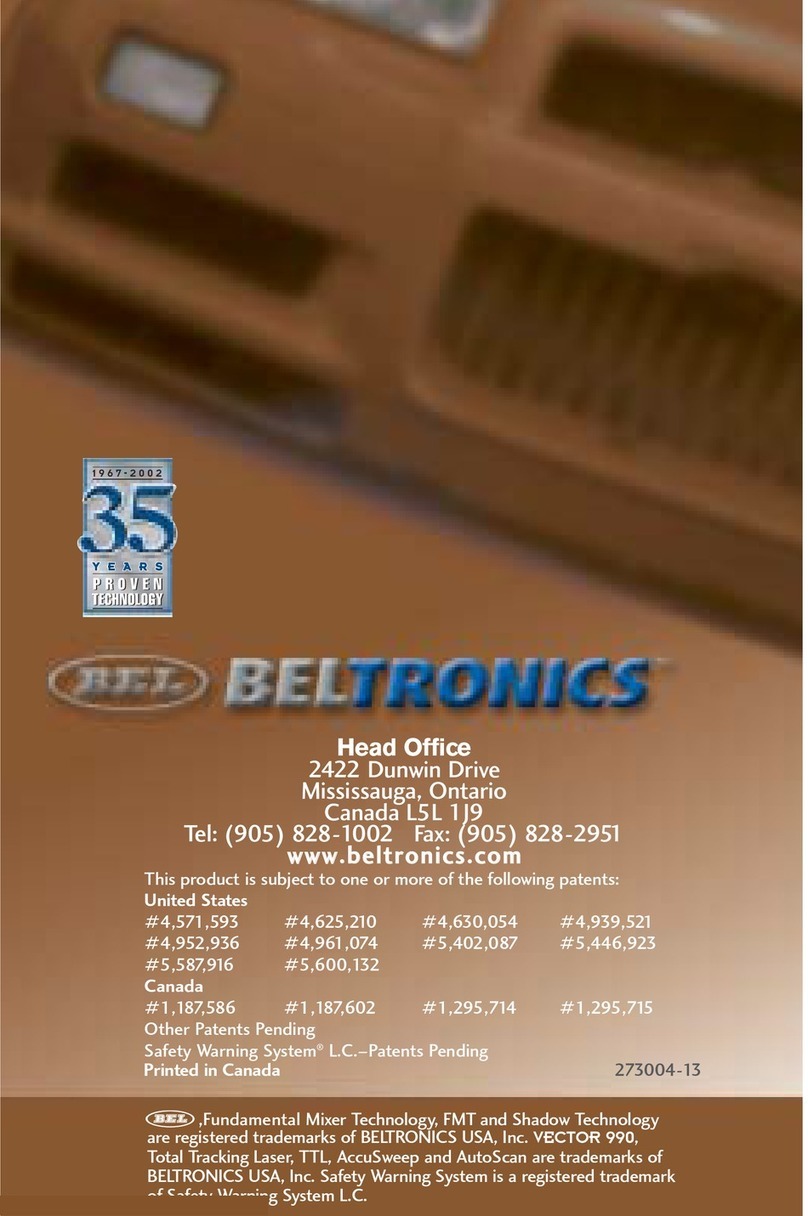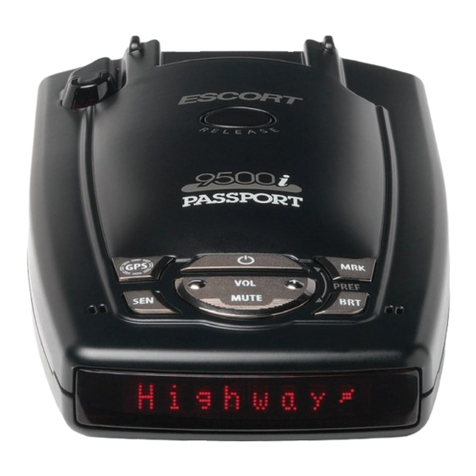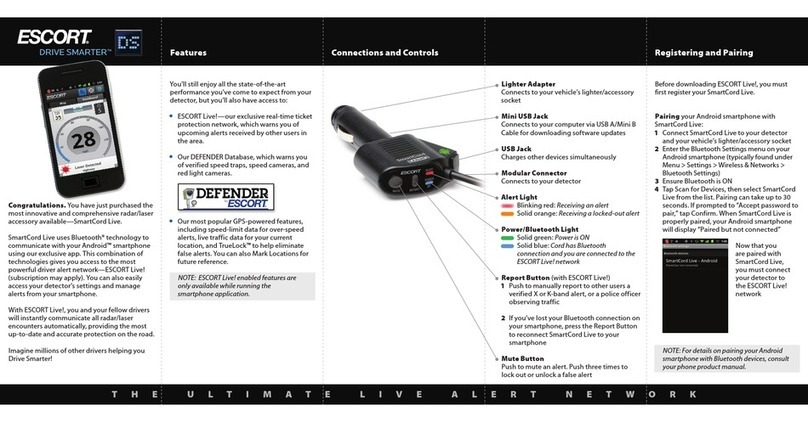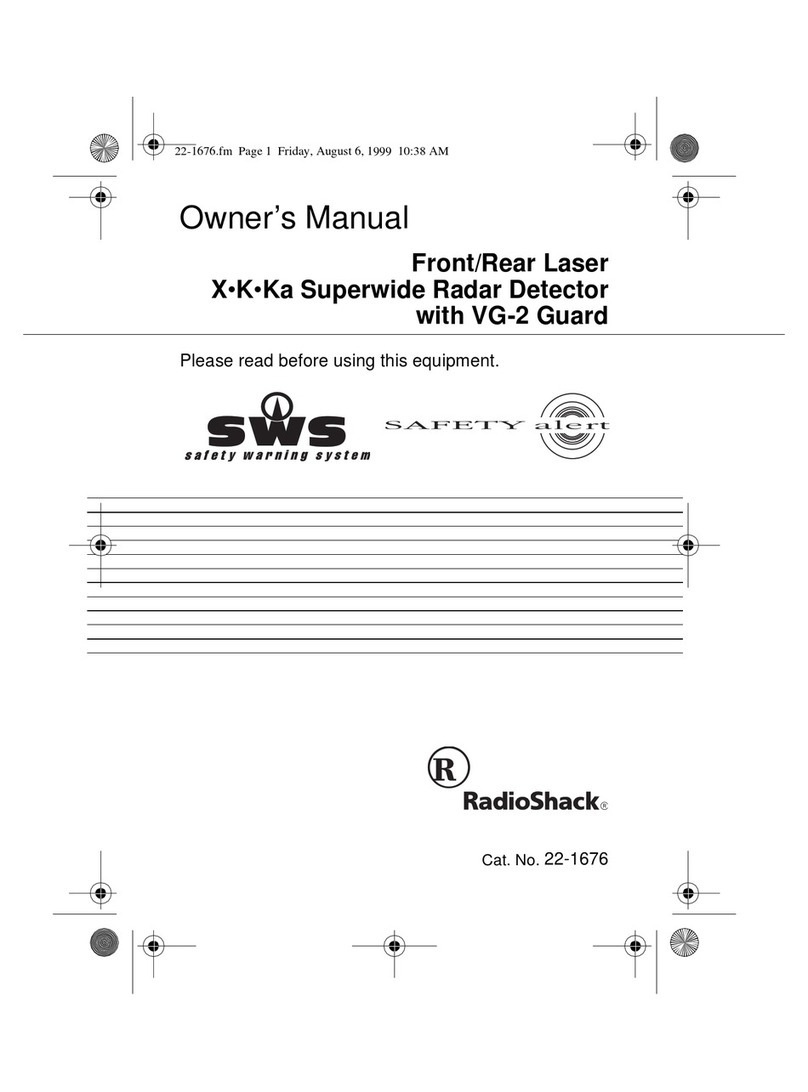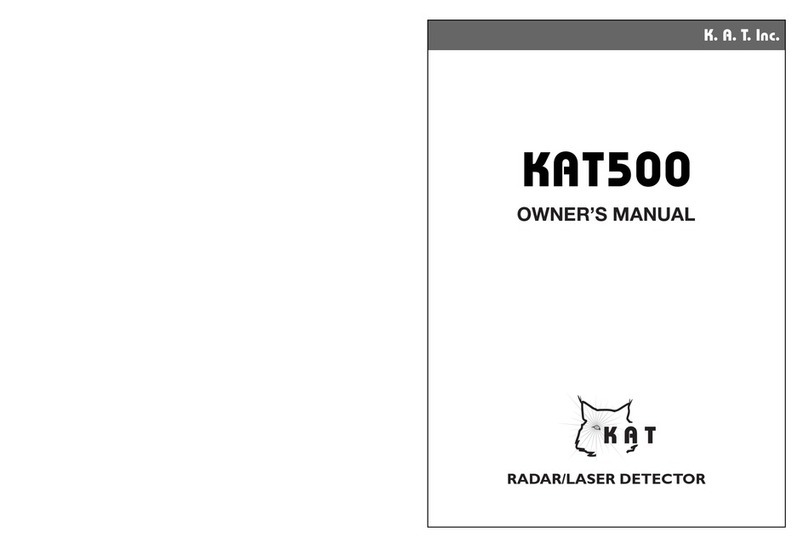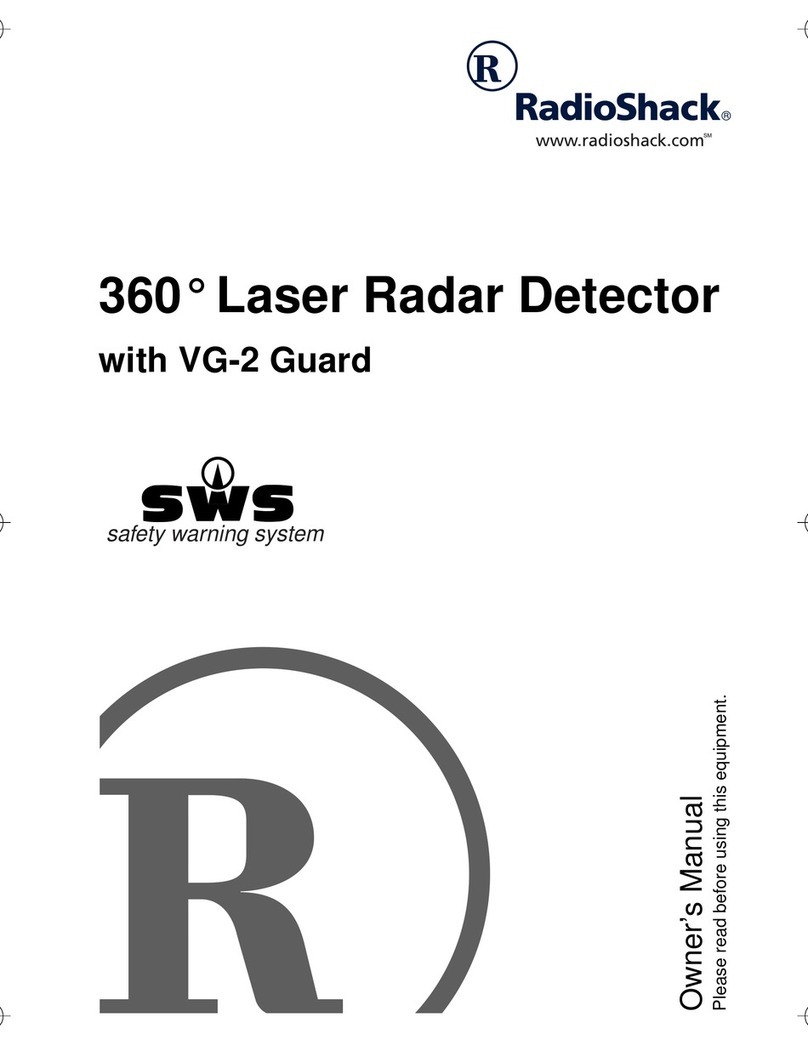Clark Systems MVD1001 User manual

S00104101MVDHandbook.doc
July 2002 1
MVD1000 Series
Radar Vehicle Detector
Handbook & Installation Guide
ÓCopyright
This document is the exclusive property of Clark Systems Limited. It may not be copied or reproduced on any media without the express
written permission of the Managing Director. The contents are for information purposes only and do not form any part of any
Contractual agreement between Clark Systems Limited and any third party unless so specified. Failure to comply shall result in
litigation of the perpetrator under the Copyrights Act.

S00104101MVDHandbook.doc
July 2002 2
This Page Left Intentionally Blank

S00104101MVDHandbook.doc
July 2002 3
Contents
Description.......................................................................................................................... 4
Installation Instructions........................................................................................................ 5
Switch setting .................................................................................................................. 5
Range selection............................................................................................................... 5
Mode selection ................................................................................................................ 6
Mounting............................................................................................................................. 6
Tilt adjustment................................................................................................................. 7
Pan adjustment................................................................................................................ 7
Connections........................................................................................................................ 8
Commissioning.................................................................................................................... 8
Problem Sites...................................................................................................................... 8
Repair & Maintenance......................................................................................................... 8
Specifications...................................................................................................................... 9
Contact Details.................................................................................................................... 9

S00104101MVDHandbook.doc
July 2002 4
Description
This detector employs proper RADAR techniques that permit all vehicles to be detected at
a predetermined range.
Conventional Doppler microwave detectors exhibit a considerable range variation,
(typically 30 - 60 meters dependent on target size). This new unit detects all vehicles,
precisely, from a pre-selected range to near the detector mounting point. Adjustment is
performed using a rotary switch (accessible via a weatherproof plug).
This approach not only provides an accurate detection range but also permits easy
installation since no 'tilt' adjustment is required, only a simple 'pan' adjustment is needed
(an accessory bracket is available for this purpose).
The unit incorporates a microwave patch antenna, which has a well-defined beam pattern.
A low-noise microwave receiver, combined with a microprocessor-based advanced signal
processing module, results in a detector of the highest quality and performance.
The prime application of this microwave detector unit is at signalised traffic installations.
The detector is normally set to detect approaching vehicles travelling above a speed
threshold, however switch settings are available to permit the unit to detect receding or bi-
directional (for shuttle working) traffic.
FEATURES
•Precise, selectable, detection range using
RADAR techniques.
•Selectable Low-Speed Threshold
•Detection of approaching, receding or bi-
directional traffic
•Lightweight, compact unit
•Advanced microprocessor controlled
signal processing
•Easy Installation
•Two Lane Coverage
•Approved by UK Highways Agency to
TR 2123 B Appendices A, C, E, F & G
Photograph 1 -
Front View of Detector

S00104101MVDHandbook.doc
July 2002 5
Installation Instructions
Switch setting
Switches should preferably be set BEFORE mounting on signal head. Access to the
switches is gained by removing the appropriate weatherproof plug, see Photograph 2.
Ensure that the plugs are replaced and securely tightened after setting the switches.
Range selection
Unless otherwise ordered detectors are normally supplied with the range set to 35m
(position 3), this is the recommended setting for most applications. Other settings are
available between 20m and 60m, as shown in Table 1. These may be selected according
to local traffic engineering requirements. For example, a shorter range may be selected to
prevent actuations from traffic on a roundabout a short distance away. It is important to
select the correct range. This detector is a true range-finding RADAR, where range is
determined by electronic processing. It CANNOT be adjusted by changing the tilt angle
(see Mounting below).
Position Range (m)
0 20
1 25
2 30
3 35
4 40
5 45
6 50
7 60
Table 1 - Range setting
Photograph 2 -
Rear View of Detector
Access to Range Switch Access to Mode Switch

S00104101MVDHandbook.doc
July 2002 6
Mode selection
Detectors are normally supplied set to detect approaching vehicles travelling at speeds
greater than the threshold of 8.5 Km/Hr (position 0). This is the normal operating mode.
Other modes are available as shown in Table 2 which may be selected according to local
traffic engineering requirements. The bi-directional (both) mode is intended for shuttle
working applications.
Position Low Speed Threshold (Km/Hr) Vehicle Direction
08.5
16.6
25.2
34.0
Approaching
48.5
56.6
65.2
74.0
Both
88.5
96.6
A5.2
B4.0
Receding
C
D
E
F
Not Used
Table 2 - Mode Settings
Mounting
A bracket is available to facilitate mounting on the upper signal head bracket using an M10
nut and bolt (supplied with bracket). Most signal head brackets are pre-drilled with an
appropriate hole, if not a hole must be drilled.
The detector is fixed to the bracket using two M6 nuts (supplied with bracket). There are
two mounting positions. The upper mounting position should be used where the signal
head backing board protrudes significantly above the head, otherwise the lower positions
should be used. In all cases the radome of the detector should be visible above the
backing board. See Photograph 3.
Photograph 3 -
Installed Detector
(Detector fitted in 'lower'
position on bracket shown)

S00104101MVDHandbook.doc
July 2002 7
Tilt adjustment
THERE IS NO TILT ADJUSTMENT. The bracket provides a fixed tilt angle (of 10o) which
is appropriate for most applications where the detector is mounted on a signal head at a
height of approximately 3.5m. This recommended tilt angle is designed to provide the best
return signal reception whilst avoiding multi-path signals and no attempt should be made
to vary it. Range is determined electronically and is not affected by changing the tilt angle.
Please consult supplier in extreme situations of mounting height or road incline for further
advice.
Pan adjustment.
The detector can be mounted either side of the carriageway. The appropriate angle
should be selected according to Table 3. The pan-angle is defined in Figure 1. Small
variations in pan may be used to accommodate roads that are not aligned at 90Oto the
signals. The angle chosen should be intended to maximize return signal in the required
detection area and minimize masking signals from vehicles outside the required detection
zone.
Single Lane Two LaneDetector
Type oNoOoNoO
MVD1001 7O16O14O16O
Table 3 - Pan-Angle Specifications
No Detection Zone
(normally receding traffic) Kerb
oOoN
Required Detection Zone (normally
approaching traffic)
Figure 1 -
Pan - Angle Definition
Note: This diagram illustrates the
layout for vehicles driving on the left-
hand side of the road (as in UK).
For right-hand side diagram should
be 'mirrored').

S00104101MVDHandbook.doc
July 2002 8
Connections
The detector is supplied with a 1m cable optionally terminated in Bulgin Buccaneer Series
PX0728/P 9 pole, weatherproof connector. Connections are given in Table 4.
Pin Circuit Colour
1Red
2Supply Black
3Earth/ Screen Green/ Screen
4Common White
5Open on Detect Yellow
6Closed on Detect Blue
7Spare Violet
8Spare Orange
9Spare Pink/ Brown
Table 4 - Connections
Commissioning
Ensure supply voltage and other connections are correct prior to connecting detector.
When the detector has been installed and is powered, observe actuations on the LED as
vehicles move within the required detection zone. Make pan adjustments as required to
ensure detection of vehicles within the detection zone and minimize masking signals from
vehicles outside the required detection zone. Changes to Range or Mode are best done
prior to mounting but can be done in-situ provided no water ingress will occur whilst the
access plugs are removed (i.e. it is not raining!). Ensure plugs are fully tightened before
leaving site. Ensure the detector is connected to the appropriate phase of the controller!
Problem Sites.
In most instances the detector will operate correctly. However there are sites where
problems may be encountered. Often this is due to reflections from metal structures or
moving objects. These include metal fences (e.g. chain link, corrugated sheet etc) and
similar objects near the detector. Pedestrian activity can also cause problems, particularly
where a low threshold speed has been selected. All radio frequency detectors suffer from
these and similar problems. Clark Systems’ detectors are designed to provide substantial
immunity from these problems, but in common with all detectors, detection cannot always
be guaranteed. Please consult supplier in the event of problems being encountered in the
field.
Repair & Maintenance
No maintenance is required other than the occasional cleaning of the Radome. A mild
detergent may be used.
There are no field maintainable components - return module to supplier for
repair/replacement. Any attempt to open or modify this equipment will invalidate its
Approval and render any warranty void.

S00104101MVDHandbook.doc
July 2002 9
Specifications
Technology:
X Band Microwave
Mounting Height:
3.5 m nominal
Indicators:
A high brightness red LED illuminates whilst the
unit detects a vehicle.
Output:
Fail-safe changeover Relay, Contacts assume
detect state when in detect state or power has
failed. A solid state output version is also
optionally available.
An RS485 interface is available for special
applications.
Operating Voltage:
24 +20% AC/DC
12 +20% AC/DC
An accessory transformer for mains use (230/115
V) is available.
Range Selection:
Range is selected by means of a rotary switch
accessible via a weatherproof plug.
Vehicle Direction and Low Speed Threshold
Selection (Mode):
These parameters are selected by means of a
rotary switch accessible via a weatherproof plug.
Turn-off time (extension):
<600 ms
EMC:
Complies with EN 50293
Environmental:
Complies with HD 638 S1
Radio Regulatory:
Complies with EN 300 440-1
Connections:
1m cable optionally terminated in Bulgin
Buccaneer Series PX0728/P 9 pole, weatherproof
connector.
Construction:
Aluminium case with extended temperature range
tough plastic radome.
Dimensions:
175 x 135 x 44 mm
Weight:
500 g
Contact Details
Clark Systems Limited
PO Box 182
Hedge End
SO30 2PL
UK
Tel: +44 (0)7092 365510
Fax: +44 (0)7092 190548
email: [email protected]
URL: www.clarksystems.co.uk
Table of contents

